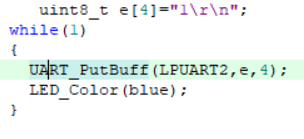可以收到
1
1
1
1
2nc3
@2nc3
2nc3 发布的帖子
-
RE: 数据接收问题,怎么办发布在 OpenMV Cam
不对
enable_lens_corr = False # turn on for straighter lines...import sensor, image, time, pyb, math
import os, tf
from machine import UART
from pyb import LED
from struct import packwhite=LED(4)
uart = UART(2, 115200)
sensor.reset()
sensor.set_auto_gain(False) # must be turned off for color tracking
sensor.set_auto_whitebal(False) # must be turned off for color tracking
#sensor.set_auto_whitebal(False)
sensor.set_pixformat(sensor.RGB565) # 灰度更快(160x120 max on OpenMV-M7)
sensor.set_framesize(sensor.QVGA)
sensor.skip_frames(time = 2000)
clock = time.clock()
thresholds=(30, 65, -27, 47, -15, 33)
#Large_area=[76,22,210,122]
net_path = "mobilenet_v2-2022-06-29T03-44-15.608Z_in-int8_out-int8_channel_ptq.tflite" # 定义模型的路径
labels = [line.rstrip() for line in open("/sd/labels_animal_fruits_traffic.txt")] # 加载标签
net = tf.load(net_path, load_to_fb=True) # 加载模型min_degree = 70
max_degree = 110#点到直线距离公式
def get_point_line_distance(point, p0, p1):
point_x = point[0]
point_y = point[1]
line_s_x, line_s_y=p0
line_e_x, line_e_y=p1
#若直线与y轴平行,则距离为点的x坐标与直线上任意一点的x坐标差值的绝对值
if line_e_x - line_s_x == 0:
return math.fabs(point_x - line_s_x)
#若直线与x轴平行,则距离为点的y坐标与直线上任意一点的y坐标差值的绝对值
if line_e_y - line_s_y == 0:
return math.fabs(point_y - line_s_y)
#斜率
k = (line_e_y - line_s_y) / (line_e_x - line_s_x)
#截距
b = line_s_y - k * line_s_x
#带入公式得到距离dis
dis = math.fabs(k * point_x - point_y + b) / math.pow(k * k + 1, 0.5)
return dis
#两点长度计算
def get_point_point_distance(p0, p1):
line_s_x, line_s_y=p0
line_e_x, line_e_y=p1
line_long = math.sqrt(pow(line_s_x-line_e_x,2)+pow(line_s_y-line_e_y,2))
return line_longwhile(True):
clock.tick()
img = sensor.snapshot().lens_corr(1.8)
white.on()
uart_str = uart.read(uart.any()).decode().strip()
print(uart_str)
if(uart_str=='1'):
print("a")
print("...........")这样我仍然无法打印a
-
数据接收问题,怎么办发布在 OpenMV Cam
# Hello World Example # # Welcome to the OpenMV IDE! Click on the green run arrow button below to run the script! import sensor, image, time, math from machine import UART uart = UART(2, baudrate=115200) sensor.reset() # Reset and initialize the sensor. sensor.set_pixformat(sensor.RGB565) # Set pixel format to RGB565 (or GRAYSCALE) sensor.set_framesize(sensor.QVGA) # Set frame size to QVGA (320x240) sensor.skip_frames(time = 2000) # Wait for settings take effect. clock = time.clock() # Create a clock object to track the FPS. thresholds = (64, 81) while(True): clock.tick() # Update the FPS clock. img = sensor.snapshot() # Take a picture and return the image. uart_num = uart.any() # 获取当前串口数据数量 if(uart_num): uart_str = uart.read(uart_num).decode().strip() # 读取串口数据 print(uart_str) if(uart_str==3): print("lllll") for blob in img.find_blobs([thresholds], pixels_threshold=100, area_threshold=100, merge=True): # These values depend on the blob not being circular - otherwise they will be shaky. if blob.elongation() > 0.5: img.draw_edges(blob.min_corners(), color=0) img.draw_line(blob.major_axis_line(), color=0) img.draw_line(blob.minor_axis_line(), color=0) # These values are stable all the time. img.draw_rectangle(blob.rect(), color=127) if blob.cy()>110 and blob.cx()<200 and blob.cx()> 160 and blob.cy()< 130: uart.write("t") print("t") elif blob.cy()< 110 and blob.cx()> 160 and blob.cx() < 200: uart.write("h") print("q") elif blob.cy()> 130 and blob.cx()<200 and blob.cx()> 160: uart.write("q") print("h") elif blob.cx()<160: uart.write("y") print("z") elif blob.cx() > 200: uart.write("z") print("y")等于3判定不通过
接受的是
3
3
3
3
3
3
这样的 -
tag码识别有误差,偏转角度时发布在 OpenMV Cam
我选择性的求了x,z的k,当摄像头与tag码平行时误差可以接受,但tag码偏转角度时,测量误差就太大了。想问一下z,x的距离是摄像头到tag码中心的距离吗,当偏转时是要再加入角度进行计算吗?
import sensor, image, time, math sensor.reset() sensor.set_pixformat(sensor.RGB565) sensor.set_framesize(sensor.QQVGA) # 如果分辨率大得多,内存就不够用了…… sensor.skip_frames(time = 2000) sensor.set_auto_gain(False) # 必须关闭此功能,以防止图像冲洗… sensor.set_auto_whitebal(False) # 必须关闭此功能,以防止图像冲洗… clock = time.clock() # 注意!与find_qrcodes不同,find_apriltags方法不需要对镜像进行镜头校正。 #标签系列有什么区别? 那么,例如,TAG16H5家族实际上是一个4x4的方形标签。 #所以,这意味着可以看到比6x6的TAG36H11标签更长的距离。 #然而,较低的H值(H5对H11),意味着4x4标签的假阳性率远高于6x6标签。 #所以,除非你有理由使用其他标签系列,否则使用默认族TAG36H11。 # AprilTags库输出标签的姿势信息。 这是x / y / z平移和x / y / z旋转。 # x / y / z旋转以弧度表示,可以转换为度数。 至于翻译单位是无量纲的, # 你必须应用一个转换函数。 # f_x是相机的x焦距。它应该等于以mm为单位的镜头焦距除以x传感器尺寸(以mm为单位)乘以图像中的像素数。 # 以下数值适用于配备2.8毫米镜头的OV7725相机。 # f_y是相机的y焦距。它应该等于以mm为单位的镜头焦距除以y传感器尺寸(以mm为单位)乘以图像中的像素数。 # 以下数值适用于配备2.8毫米镜头的OV7725相机。 # c_x是以像素为单位的图像x中心位置 # c_x是以像素为单位的图像x中心位置 f_x = (2.8 / 3.984) * 160 # find_apriltags 如果没有设置,则默认为这个 f_y = (2.8 / 2.952) * 120 # find_apriltags 如果没有设置,则默认为这个 c_x = 160 * 0.5 # find_apriltags 如果没有设置,则默认为这个 (the image.w * 0.5) c_y = 120 * 0.5 # find_apriltags 如果没有设置,则默认为这个 (the image.h * 0.5) k_z=-5.97 k_x=11.159 def degrees(radians): return (180 * radians) / math.pi while(True): clock.tick() img = sensor.snapshot() for tag in img.find_apriltags(families=image.TAG25H9,fx=f_x, fy=f_y, cx=c_x, cy=c_y): # 默认为 TAG36H11 img.draw_rectangle(tag.rect(), color = (255, 0, 0)) img.draw_cross(tag.cx(), tag.cy(), color = (0, 255, 0)) print_args = (tag.x_translation(), tag.y_translation(), tag.z_translation(), \ degrees(tag.x_rotation()), degrees(tag.y_rotation()), degrees(tag.z_rotation())) # 变换单位不详。旋转单位是度数。 #print("Tx: %f, Ty %f, Tz %f, Rx %f, Ry %f, Rz %f" % print_args) print(tag.id(),"x:",k_x*tag.x_translation()," z:",k_z*tag.z_translation()) print(clock.fps()) -
RE: 我在uart.write(c[0].x,c[1].x等等点)时会报错,让我不要加[],发布在 OpenMV Cam
import sensor, image, time, pyb sensor.reset() sensor.set_pixformat(sensor.RGB565) # grayscale is faster sensor.set_framesize(sensor.QQVGA) sensor.skip_frames(time = 2000) clock = time.clock() while(True): clock.tick() img = sensor.snapshot().lens_corr(1.8) # Circle objects have four values: x, y, r (radius), and magnitude. The # magnitude is the strength of the detection of the circle. Higher is # better... # `threshold` controls how many circles are found. Increase its value # to decrease the number of circles detected... # `x_margin`, `y_margin`, and `r_margin` control the merging of similar # circles in the x, y, and r (radius) directions. # r_min, r_max, and r_step control what radiuses of circles are tested. # Shrinking the number of tested circle radiuses yields a big performance boost. for circles in img.find_circles(threshold = 2000, x_margin = 10, y_margin = 10, r_margin = 10, r_min = 2, r_max = 100, r_step = 2): img.draw_circle(c.x(), c.y(), c.r(), color = (255, 0, 0)) c0=circles[0].x() print(c0)最后就会显示AttributeError: 'int' object has no attribute 'x'

